German Spaetzle means German comfort food to me.
What Is Spaetlze?
So these are German noodles common in southern German (Swabian noodles actually). The name means 'little sparrows' maybe because when they are cooked they are small, twisted drops of dough. Some call them noodles and some call them tiny dumplings.
Flour, eggs, salt and water. Such simple ingredients, like many pastas and dumplings.
I am lucky that in our German community you can buy them dried from European delis and you cook them just like pasta.
But I have watched my mother in-law scrape or drop dough into a pot of boiling water so often that I thought why not try it myself.
How Do You Make Spaetzle?
The dough comes together so easily. You mix the flour and salt together and then whisk in the egg. Finally you add water.
The trick is to get the right consistency of the dough. It should be like thick cake batter -pourable but not runny.
You can buy commercial spaetzle makers but you don't really have to. What you want to achieve are drops of dough that when you press it against the holes of a flat grater will pass through and stretch and break off into the pot of boiling, salted water you have prepared.
You should be able to take a swath of dough on a spatula and smear it across the flat side of your grater (the opposite side from the one you would use to actually grate something). The dough should not drip through the holes on its own. It should sit on the flat side until you nudge it through the holes by rubbing the spatula across the dough.
The dough should stretch and eventually drop off on its own into the boiling water below. This will give you various sized. The swirling of the boiling water will twist the dough into a short curly noodle -blobs.
I tried it through the large holes in my potato ricer which some people recommend but the dough wanted to clump back together after it was pressed out of the disc. It wouldn't stretch and drop.
I don't have a spaetzle maker so I can't speak to that. What worked beautifully for me was a flat hand held grater (photo below) that I could easily drag the spatula across to press the dough out the holes. Size was perfect and they little bits all dropped off from their own weight.
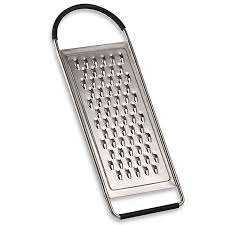
You let the dough sit for about 10 minutes before you start pressing it out. While that is going on melt some butter in a skillet on a second burner.
They say that spaetzle is done when the little noodles float to the top. You will skim them off with a slotted spoon and transfer to the butter in the skillet to coat them. This will keep them warm and keep them from clumping together.
I found that if I skimmed them out as soon as they rose the dough tasted a bit raw. So I pressed out about half my dough and then skimmed the noodles out when everything was floating. Then I pressed out the second half of the dough and repeated. I liked the spaetzle best like this.
It is a real treat to serve these freshly made right from the pot/skillet to the table. But that may not be convenient.
If you are making a sizeable batch you may want to make them well ahead and reheat them gently. The process is the same except that you will let them cool after they are tossed and coated with the butter in the skillet and then you will gently reheat them in the skillet just before serving.
How Do I Serve Spaetzle?
Here is the beauty of spaetzle! You can serve them just with the butter coating (taste for salt); you can grate some cheese on top; you can reheat them with some eggs in the skillet stirring to create soft scrambled eggs in the midst of the spaetzle; or you can treat them like any egg noodle that you might use as a base for a stroganoff or roasted or braised meat.
I served them with this Pork Stroganoff and they were a match made in heaven!
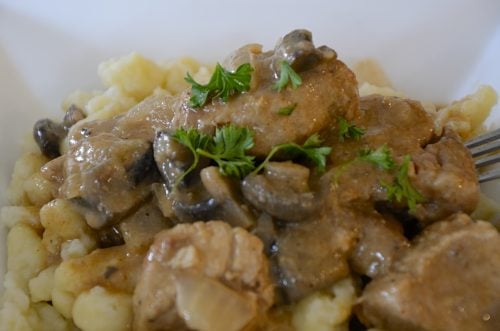
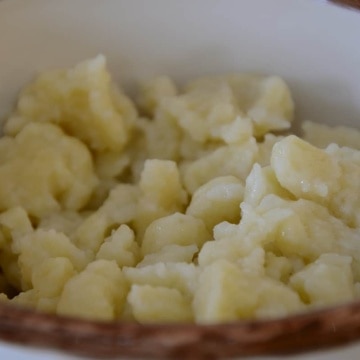
Equipment
- flat grater or spaetzle maker
Ingredients
- 2 ¼ cups flour
- 1 teaspoon salt
- 2 eggs
- ½ - 1 cup water
- 2 tablespoon Butter
Instructions
- Bring a large pot of salted water to a boil.
- Mix flour and salt in a bowl. Whisk the eggs lightly and then mix into the flour.
- Gradually add the water until you have a 'batter' like a thick cake batter. It should be pourable but not runny. See Note 1 below.
- Let dough rest for about 10 minutes.
- Melt butter in a large skillet over medium low heat.
- Hold the grater over the pot of boiling water with the flat side facing you. Take a swath of dough on a spatula and drag it along the grater. The dough should not run through the grater on its own, but it should stretch and drip easily when you smear it through the holes with the spatula.
- Allow the weight of the 'batter' to make it drop off the grater into the water. The water should be boiling but not furiously.
- The spaetzle will float to the top when they are cooked. You can stir the pot gently with separate the noodles. I like to press out half the dough and when everything is floating, I skim out the noodles with a slotted spoon. Transfer to the butter in the skillet.
- Repeat with the remaining dough.
- Test and adjust for salt as required.
- You can serve immediately or allow buttered spaetzle to cool down and reheat gently if making ahead.

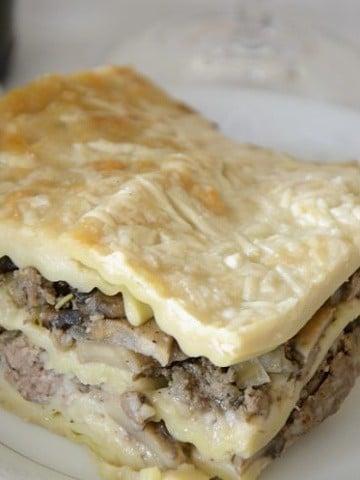
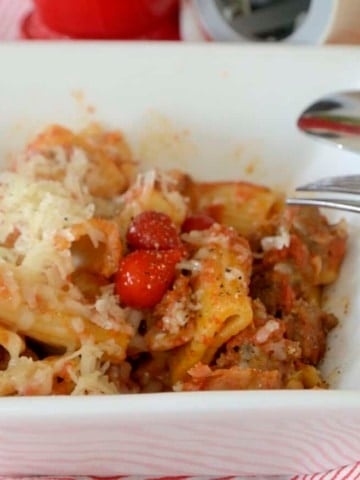
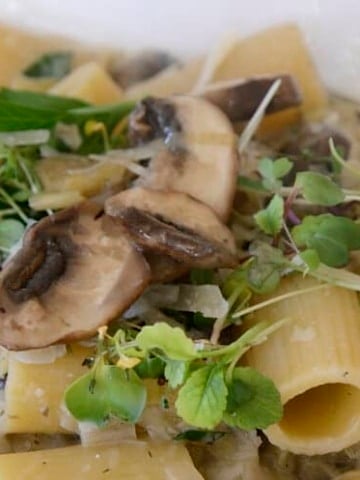

Leave a Reply